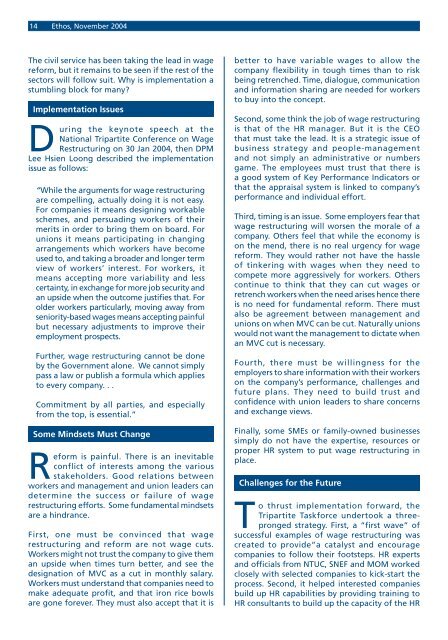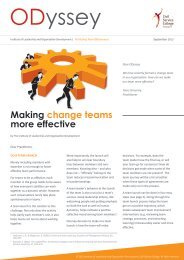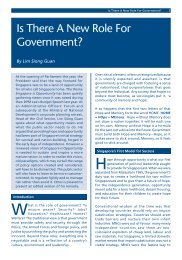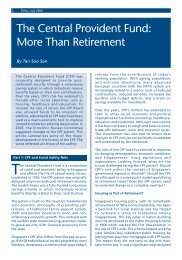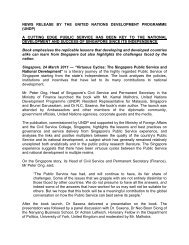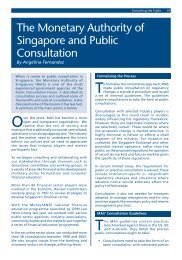Wage Reform & Tripartism : A Test of Trust At Work - Civil Service ...
Wage Reform & Tripartism : A Test of Trust At Work - Civil Service ...
Wage Reform & Tripartism : A Test of Trust At Work - Civil Service ...
You also want an ePaper? Increase the reach of your titles
YUMPU automatically turns print PDFs into web optimized ePapers that Google loves.
14 Ethos, November 2004The civil service has been taking the lead in wagereform, but it remains to be seen if the rest <strong>of</strong> thesectors will follow suit. Why is implementation astumbling block for many?Implementation IssuesDuring the keynote speech at theNational Tripartite Conference on <strong>Wage</strong>Restructuring on 30 Jan 2004, then DPMLee Hsien Loong described the implementationissue as follows:“While the arguments for wage restructuringare compelling, actually doing it is not easy.For companies it means designing workableschemes, and persuading workers <strong>of</strong> theirmerits in order to bring them on board. Forunions it means participating in changingarrangements which workers have becomeused to, and taking a broader and longer termview <strong>of</strong> workers’ interest. For workers, itmeans accepting more variability and lesscertainty, in exchange for more job security andan upside when the outcome justifies that. Forolder workers particularly, moving away fromseniority-based wages means accepting painfulbut necessary adjustments to improve theiremployment prospects.Further, wage restructuring cannot be doneby the Government alone. We cannot simplypass a law or publish a formula which appliesto every company. . .Commitment by all parties, and especiallyfrom the top, is essential.”Some Mindsets Must Change<strong>Reform</strong> is painful. There is an inevitableconflict <strong>of</strong> interests among the variousstakeholders. Good relations betweenworkers and management and union leaders candetermine the success or failure <strong>of</strong> wagerestructuring efforts. Some fundamental mindsetsare a hindrance.First, one must be convinced that wagerestructuring and reform are not wage cuts.<strong>Work</strong>ers might not trust the company to give theman upside when times turn better, and see thedesignation <strong>of</strong> MVC as a cut in monthly salary.<strong>Work</strong>ers must understand that companies need tomake adequate pr<strong>of</strong>it, and that iron rice bowlsare gone forever. They must also accept that it isbetter to have variable wages to allow thecompany flexibility in tough times than to riskbeing retrenched. Time, dialogue, communicationand information sharing are needed for workersto buy into the concept.Second, some think the job <strong>of</strong> wage restructuringis that <strong>of</strong> the HR manager. But it is the CEOthat must take the lead. It is a strategic issue <strong>of</strong>business strategy and people-managementand not simply an administrative or numbersgame. The employees must trust that there isa good system <strong>of</strong> Key Performance Indicators orthat the appraisal system is linked to company’sperformance and individual effort.Third, timing is an issue. Some employers fear thatwage restructuring will worsen the morale <strong>of</strong> acompany. Others feel that while the economy ison the mend, there is no real urgency for wagereform. They would rather not have the hassle<strong>of</strong> tinkering with wages when they need tocompete more aggressively for workers. Otherscontinue to think that they can cut wages orretrench workers when the need arises hence thereis no need for fundamental reform. There mustalso be agreement between management andunions on when MVC can be cut. Naturally unionswould not want the management to dictate whenan MVC cut is necessary.Fourth, there must be willingness for theemployers to share information with their workerson the company’s performance, challenges andfuture plans. They need to build trust andconfidence with union leaders to share concernsand exchange views.Finally, some SMEs or family-owned businessessimply do not have the expertise, resources orproper HR system to put wage restructuring inplace.Challenges for the FutureTo thrust implementation forward, theTripartite Taskforce undertook a threeprongedstrategy. First, a “first wave” <strong>of</strong>successful examples <strong>of</strong> wage restructuring wascreated to provide”a catalyst and encouragecompanies to follow their footsteps. HR expertsand <strong>of</strong>ficials from NTUC, SNEF and MOM workedclosely with selected companies to kick-start theprocess. Second, it helped interested companiesbuild up HR capabilities by providing training toHR consultants to build up the capacity <strong>of</strong> the HR


